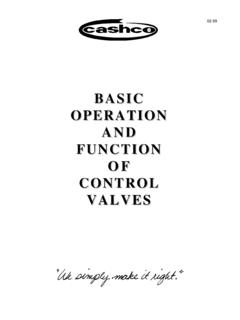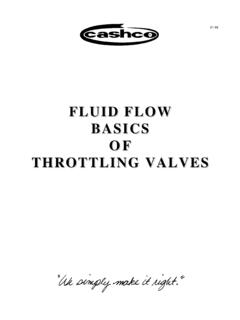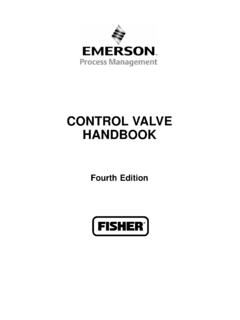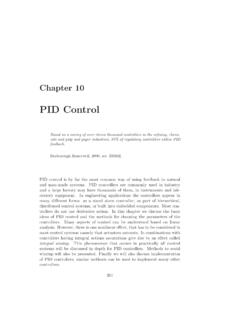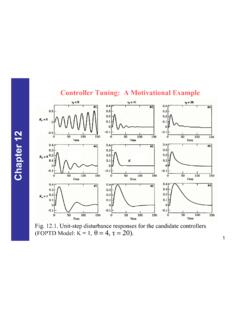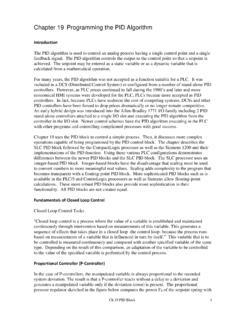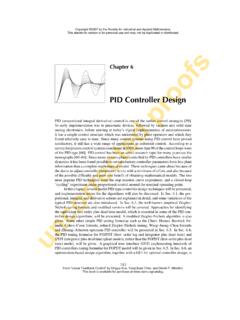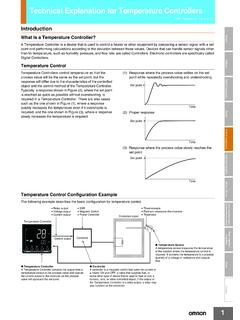Transcription of Lambda Tuning the Universal Method for PID Controllers in ...
1 Lambda Tuning the Universal Method for PID Controllers in Process Control Lambda Tuning gives non-oscillatory response with the response time ( Lambda ) required by the plant. Seven industrial examples show the relevance and simplicity of this Method . Will Lambda Tuning work in your process control loop? by Mark T. Coughran PID Proportional+Integral+Derivative--is by far the most common feedback control algorithm in the process industries. Many control engineers are asked to choose the P, I, and D controller Tuning parameters. Often we are faced with one or more of these six common challenges: Process Challenge Requirement Lambda ( ) Tuning Solution Oscillation with as-found Tuning First-order setpoint response or critically damped load response Any >> Td Need minimum variability on PV Fast response of control loop; shift variability to Output = 3*Td (minimum robust ) Surge vessel to absorb variability.
2 Need minimum variability on Output Slow response of liquid level control loop LEVEL as large as possible Cascade configuration Slave loop must respond faster than master loop MASTER >> SLAVE Physically coupled or interacting processes Uncouple the loop dynamics LOOP B >> LOOP A Multiple streams into blending vessel All inflows respond at same speed to inventory control FLOW A = FLOW B = FLOW N Given these challenges, what is a systematic and practical way to find the optimal parameters? Don t confuse yourself with arcane statistics; use your knowledge of the plant. Start with the purpose of the loop, possible interactions with other loops, and the ability of the process to respond to the controller (the process dynamics).
3 For example, there are practically no control loops in the process industries whose purpose is to oscillate. To comply with the production objectives of the plant, and to prevent interactions between loops, most loops need to respond in a certain amount of time. Learning which loops need to be fast and which need to be slow will make your Tuning efforts more valuable to the plant. Finally, the process dynamics (MANUAL response) will limit how fast you can make the closed loop (AUTO) response. Figure 1. Basic feedback control loop. ProcessControllerLoadProcess Value (PV)Output +-Set Point (SP) Lambda Tuning has proven successful in thousands of control loops covering the following process control applications: feedback control loops (Figure 1) in continuous and batch processes.
4 PID Controllers of all types--DCS, PLC, single-loop, pneumatic--from all manufacturers. physical processes including flow, pressure (liquids and gases), level (liquids and solids), temperature (heat exchange, mixing, reaction), and composition (density, pH, stack O2, dissolved oxygen, etc.). process industries including chemicals, refining, oil & gas, power, life sciences, pulp & paper, metals & mining, and pipeline. the environments of brownfield plant optimization, greenfield plant startup, design and simulation of control systems, and education. Lambda Tuning Concepts Lambda Tuning is a model-based Method related to Internal Model Control and Model Predictive Control.
5 The math behind it uses pole-zero cancellation to achieve the desired closed loop response. However, to apply the Method you need only simple arithmetic--as in Figure 2--if your process dynamics fit any of the following models: a) First Order b) Integrator c) Integrator, First Order Lag d) Integrator, First Order Lead e) Integrator, Non-Minimum Phase f) Second Order, Overdamped g) Second Order, Underdamped h) Second Order, Lead i) Second Order, Lead with Overshoot j) Second Order, Non-Minimum-Phase Each process model includes dead time. Types a) and f) j) are self-regulating; that is, for an output step, the PV eventually settles at a new value.
6 The process dynamics model is typically identified from step testing in MANUAL mode (open loop). Step tests also help to identify the nonlinearities in the process response, such as dead band in control valves, which may be a greater problem than the as-found controller Tuning . We assume the controller block in Figure 1 contains a PID algorithm. The process block includes the final control element or slave loop, the process to be controlled (chemistry, hydraulics, thermal energy, etc.) and the sensor/transmitter. Lambda Tuning gives a non-oscillatory response to setpoint changes and load disturbances.
7 You choose the response time ( Lambda or ) to fit the control strategy and the unit production objectives. Most of the processes in your plant will fit either the first order model or the integrator model. a) First-Order Process Dynamics: if the process has the following self-regulating open loop response then we define Lambda ( ) as the closed loop time constant after a setpoint step. Time constant has the familiar meaning of the time to reach 63% of the final value. For simplicity, we show here the closed loop response with negligible dead time: To accomplish this in the PID controller , we set Proportional Gain = Integral Time = Derivative Time = 0 (none) b) Integrator Process Dynamics: if the process has the following integrating open loop response then we define a critically damped load response with Lambda ( ) equal to the arrest time.
8 For simplicity, we show here the closed loop response with negligible dead time: To accomplish this in the PID controller , we set Proportional Gain Integral Time = 2 +Td Derivative Time = 0 (none) Figure 2. Lambda Tuning Method for the two simplest and most common process responses. The process response, in particular the dead time Td, limits how small you can make . For further explanation of the math, see the References. The process models shown in Figure 2 are built into some control system Tuning tools. The ideal tool would include process model identification, the arithmetic for Lambda Tuning , recommendations for choice of Lambda , and predicted setpoint and load responses.
9 Process Plant Examples Let s look at several examples from process plants. In each example, Lambda has a clear physical meaning. We begin with self-regulating process dynamics. Figure 3 shows a typical result for flow loops. Figure 3. Closed loop flow rate control of Natural Gas Liquids through a control valve into a depropanizer column. The PID controller executes in a DCS. The process model is self-regulating first order plus dead time. The dead time (occurring both in open loop and closed loop) is mostly due to nonlinearity in the response of the control valve. Robustness of the controller Tuning takes into account that the process dynamics (process gain, dead time, and time constant) may change considerably at other process conditions.
10 For robustness it is wise to choose Lambda equal to a generous multiple of the dead time. Note we chose =3*Td in the above case. Figure 4. Pressure control of lubricating oil pumped from a reservoir to the propylene compressor of an olefins unit. Maintaining the oil pressure is critical to operation of the unit. The pressure is controlled by routing part of the flow back to the reservoir through a bypass control valve. The PID executes in a pneumatic controller , where the oil is connected directly to the controller sensing element and the output (3-15 psig) goes to a pneumatic positioner on the bypass valve.
